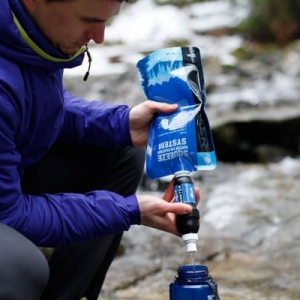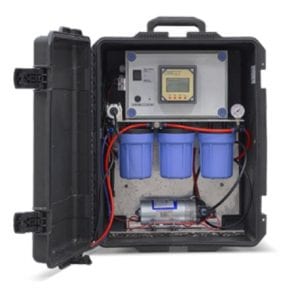
Agriculture
December 29, 2023
Sawyer PointOne Filter
Read SolutionImplemented by
Sawyer

Updated on January 3, 2024
·Created on August 27, 2015
WaterGuard is a dilute sodium hypochlorite solution used as a point-of-use treatment for household drinking water.
WaterGuard (also know as Sur’Eau in French-speaking regions) is a household chemical water treatment method distributed by Population Services International (PSI). This point-use water treatment is a controlled chlorine dosing method. It does not require the level of monitoring or use of complex equipment like traditional gas systems. WaterGuard is part of the Safe Water System (SWS), a water quality intervention program to be used in collaboration with safe water storage, and behavioral change communication. Correct use of the product in combination with SWS has shown to reduce diarrheal disease incidence in users by 22-85%.
Target SDGs
SDG 6: Clean Water and Sanitation
SDG 3: Good Health and Well-Being
Market Suggested Retail Price
$0.33
Target Users (Target Impact Group)
Household
Distributors / Implementing Organizations
The PSI is the major community distributor. Partnerships with PATH (funded by the Bill and Melinda Gates Foundation & CDC), the University of Malawi in conjunction with CDC, Pan American Health Organization (PAHO) and World Health Organization (WHO), have also facilitated distribution and implementation of the product.
Competitive Landscape
Direct competitors include MSR SE200 Community Chlorine Maker, P&G Purifier of Water, and Gadyen Dlo.
Regions
Asia, Southeast Asia, Southern Africa
Manufacturing/Building Method
The product is listed as locally manufactured, details on the manufacturing process are not discussed.
Intellectural Property Type
Open-source
User Provision Model
Users are most likely to purchase WaterGuard from their local supermarket, pharmacy, or street vendors. In some rural areas, users can contact WaterGuard's community sales agents to obtain the product.
Distributions to Date Status
WaterGuard bottles have been distributed worldwide in WASH intervention strategies. The number of products distributed to date is unknown but is estimated to be over 1,000,000s with 30,000 units delivered to Monrovia, Liberia in 2012 alone.
Active Chemical and concentration (%)
Sodium Hypochlorite, 1.25%
Form
Liquid
Dosing method: Batch or flow-through
Batch
Dosing method: Automatic or manual
Manual
Dosing quantity
3mL (1 cap) per 20L for water >30NTU
6mL (2 caps) per 20 L for water >100NTU
Contact time (min)
30 mins
Target free disinfectant residual (mg/L)
2 mg/L
Bacteria reduction
2 log (E. coli)
Virus reduction
2 log (enteroviruses)
Protozoa reduction
3 log (E. Histolytica, G. Lambilia, Cryptosporidium.)
Heavy metals and/or arsenic reduction
No
Treatment lifespan (days)
7 days if treated water is stored in a narrow neck container with a tight fitting.
Maximum recommended influent turbidity level (NTU)
>100 NTU
Design Specifications
The water treatment product is made from sodium hypochlorite, 12.5% diluted to 1.25% by weight.
The 150mL standard bottle is suggested to serve a family’s water needs for approximately a week. The cap is used for measuring doses, with one cap referred to as a single dose. A cap of WaterGuard 3mL is added to 20L of water >30NTU, in a container with a tight-fitting lid. The container is agitated and left for 30min for sanitation to complete. Two caps are required for water with high turbidity levels (>100NTU), with pre-filtration methods recommended before the addition of WaterGuard.
Technical Support
PSI has an info-graphic showing the appropriate use of this product. Users may also refer to the Safe Water Training Manual for Village Health Teams, created by PSI Uganda and UNICEF.
Replacement Components
Not applicable
Lifecycle
Sodium hypochlorite degrades over time. Studies have found that in ideal conditions, chlorine concentration significantly decreases. Products of original concentration 13% sealed, at 80F, away from direct sunlight, were found to decrease in concentration to 8% over 75 days. This should be taken into account when treating water. Users must consult Federal, State, and Local regulations for disposal.
Manufacturer Specified Performance Parameters
This water treatment is designed to remove 99.9% of bacteria.
Vetted Performance Status
Testing performed by the CDC determined a 22-84% reduction in diarrhea incidence. Field use in rural Tanzania has found a 95.4% TTC reduction after water was treated with WaterGuard.
Safety
The product should be used as per dosage guidelines. The maximum use limit must not exceed 84mg/L. This product should not be mixed directly with any other chemical.
Microbiological effectiveness is limited by turbidity of the raw water. The effectiveness of WaterGuard decreases proportionately to turbidity levels. WaterGuard is unable to effectively treat raw water with turbidity levels greater than 100NTU.
The use of chlorine water treatment is hazardous if incorrectly monitored. Trihalomethanes (THMs) are formed in drinking-water as a result of chlorination of organic matter present in raw water supplies. High concentrations of these compounds are linked to a variety of health issues such as cancer and reproductive issues. The World Health Organisation advises THM levels in drinking water to be kept as low as possible. The point-of-use chlorination of water in Kenya has shown compliance with WHO THM guideline values.
Complementary Technical Systems
If the water turbidity is greater than 30NTU, 2 caps must be used. Preliminary filtration using a cloth is recommended before adding WaterGuard.
If NTU is greater than 100NTU alternative treatments should be used, as WaterGuard is ineffective at these levels.
Academic Research and References
Luoto, et al. 2011, What point-of-use water treatment products do consumers use? Evidence from a randomized controlled trial among the urban poor in Bangladesh, PLoS One; 6(10): e26132
Reller et al., 2001, Cholera Prevention With Traditional and Novel Water Treatment Methods: An Outbreak Investigation in Fort-Dauphin, Madagascar, Vol91, No.10
Tersagh, I, et al., 2015. Efficacy of Water Guard Disinfectant as a Domestic Stored Water Treatment Method in Makurdi Metropolis. Research Journal of Environmental Sciences, 9: 364-369.
Mohamed, H., et al, 2015, Point-of-use chlorination of turbid water: results from a field study in Tanzania, Journal of Water and Health, 13 (2): 544-552.
Yohanna, L., and Mashauri, D., 2008, Potential Use of WaterGuard as a disinfectant for domestic water use Tanzania Journal of Engineering and Technology 31(2): 62-69
Lule JR., et al. 2005, Effect of home-based water chlorination and safe storage on diarrhea among persons with human immunodeficiency virus in Uganda. American Journal of Tropical Medicine & Hygiene. 2005;73(5):926?933.
H. Mohamed, T. Clasen, R. M. Njee, H. M. Malebo, S. Mbuligwe, and J. Brown, “Microbiological effectiveness of household water treatment technologies under field use conditions in rural Tanzania,” Trop. Med. Int. Health, vol. 21, no. 1, pp. 33–40, 2016.
E. Hood, “Tap water and trihalomethanes: Flow of concerns continues,” Environ. Health Perspect., vol. 113, no. 7, pp. A474–A474, 2005
D. S. Lantagne, B. C. Blount, F. Cardinali, and R. Quick, “Disinfection by-product formation and mitigation strategies in point-of-use chlorination of turbid and non-turbid waters in western Kenya,” J. Water Health, vol. 6, no. 1, pp. 67–82, 2008.
P. Makutsa et al., “Challenges in implementing a point-of-use water quality intervention in rural Kenya,” Am. J. Public Health, vol. 91, no. 10, pp. 1571–1573, 2001.
“Where We Work?:,” PSI, 18-Sep-2021/ Available: https://www.psi.org/where-we-work/
“Water Disinfection with Chlorine and Chloramine,” Cdc.gov, 18-Nov-2020. Available: https://www.cdc.gov/healthywater/drinking/public/water_disinfection.html
“P&G purifier of water packets – a simple way to clean water,” Csdw.org. Available: https://csdw.org/pg-purifier-of-water-packets/
“Goal 6,” Sdgs.un.org. Available: https://sdgs.un.org/goals/goal6
“Water, Sanitation and Hygiene?:,” PSI, 03-Mar-2020. Available: https://www.psi.org/practice-area/wash/
Alnap.org. Available: https://www.alnap.org/system/files/content/resource/files/main/wash-systematic-review.pdf
Fhi360.org. Available: https://hip.fhi360.org/file/21859/PG%20Unit%203.pdf
“Preventing diarrheal disease in developing countries: Proven household water treatment options,” Cdc.gov, 2008. Available: https://www.cdc.gov/safewater/publications_pages/proven.pdf
waponline.com. Available: https://iwaponline.com/jwh/article/13/2/544/28357/Point-of-use-chlorination-of-turbid-water-results
“Global network,” CARE International. Available: https://www.care-international.org/who-we-are/global-network
Compliance with regulations
The product is endorsed by PSI and complies with the South African National Standard 241 Drinking Water Specifications.
Evaluation methods
The manufacturer product cites log 4 removals of bacteria for water treated with WaterGuard. The evaluation criteria primarily are for the removal of E.coli, E. Histolytica, G. Lambilia, Cryptosporidium enteroviruses. Third-party testing is conducted by the CDC.
Other Information
WaterGuard is also available in tab form, the product was previously known as Klorin. This was originally produced by CARE.

Agriculture
December 29, 2023
Implemented by
Sawyer

Agriculture
June 26, 2024
Implemented by
SweetSense Inc

Agriculture
January 3, 2024
Implemented by
Antenna Technologies

Agriculture
December 27, 2023
Implemented by
Aqua Clara International

Agriculture
January 10, 2024
Implemented by
Dr. David Manz, University of Calgary

Agriculture
January 11, 2024
Implemented by
Kohler

Agriculture
January 11, 2024
Implemented by
New Millennium Concepts, Ltd

Agriculture
January 24, 2024
Implemented by
3M

Agriculture
January 24, 2024
Implemented by
Folia Water

Agriculture
January 25, 2024
Implemented by
MuchMoreWater
Have thoughts on how we can improve?
Give Us Feedback
How do i get this water guard locally?